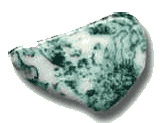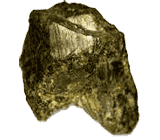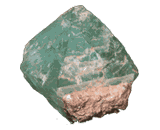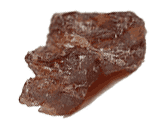| Gemstone Chart |
 Natural Agate Natural Agate
Agate is a beautiful natural chalcedony stone, classified as a semi precious gem and has been used by people as early as the ancient Egyptians in and before 3000 BC! Agate is hard and tough enough to be incorporated into jewelry and other ornamental items.
Color: Blue, green, yellow,orange, brown, gray
Categories: semi-precious stone
Chemical Composition: SiO2
Crystal Group: Hexagonal
Refractive Index: 1.530 - 1.539
Hardness: 6.5 - 7
Density: 2.57 - 2.64
Occurrence: Scotland, U.S.A., India, England, Italy, Brazil, Uruguay, Germany, Egypt, Indonesia, and many other localities.
|  Natural Chalcedony Natural Chalcedony
Chalcedony is a catch all term that includes many well known varieties of cryptocrystalline quartz gemstones. They are found in all 50 States, in many colors and color combinations, and in sedimentary, igneous, and metamorphic rocks.
Color: grayish, purple, white, green, blue, lavender, yellow, brown
Categories: semi-precious stone
Chemical Composition: SiO2
Crystal Group: Hexagonal
Refractive Index: 1.530 - 1.539
Hardness: 6.5
Density: 2.57 – 2.64
Occurrence: Brazil, U.S.A. Germany, India, Uruguay, Austarlia, Egypt, Italy, Scotland, South Africa, Namibia, Madagascar, Mexico, Tanzania, and many other localities throughout the world.
|  Natural Enstatite Natural Enstatite
Enstatite is a relatively common mineral, but is rarely used for jewelry purposes. It is generally cut for gem connoisseurs and collectors rather than for the common consumer.
Color: Gray, green, brown, orange-brown, yellowish-brown, colorless, pale yellow.
Categories: semi-precious stone
Chemical Composition: MgSiO3
Crystal Group: Orthorhombic
Refractive Index: 1.663-1.673
Hardness: 5.5
Density: 3.26-3.28
Occurrence: South Africa, Burma, Tanzania, Sri Lanka, Kenya, Germany, Norway, Greenland
|  Natural Fluorite Natural Fluorite
Fluorite has a wide range of colors including yellow, blue, pink purple and green. It is an interesting and beautiful gemstone.
Color: Colorless, yellow, brown, green, blue, violet, pink
Categories: semi-precious stone
Chemical Composition: CaF2
Crystal Group: Cubic
Refractive Index: 1.43
Hardness: 4
Density: 3.18
Occurrence: Namibia, U.K., Switzerland, Nigeria, Czechoslovakia, Canada, Poland, Italy, Norway, Germany, U.S.A.
|  Natural Spessartite Natural Spessartite
The Spessartite is one of the most popular of all garnets. It is highly desired by collectors, jewelry designers and gem lovers.The sources for gem quality spessartine are Sri Lanka and Brazil.
Color: Orange, yellow, brown
Categories: semi-precious stone
Chemical Composition: Mn3Al2(SiO4)3
Crystal Group: Cubic
Refractive Index: 1.79-1.81
Hardness: 7.25
Density: 4.14-4.20
Occurrence: Germany, Ceylon, Burma, Nigeria, Maevatanana-Madagascar, Isoanala-Madagascar, East Africa.
|  Natural Topaz Natural Topaz
Topaz is a silicate mineral most often found in igneous rocks of felsic composition. It is a common gemstone that has been used for centuries in jewelry. Gem quality topaz most commonly occurs in nature as a colorless crystal. It is a very popular gemstone.
Color: colorless, blue, yellow-brown, pinkish orange, red-orange, red-brown, tan.
Categories: semi-precious stone
Chemical Composition: AL(F,OH)2SIO4
Crystal Group: Orthorhombic
Refractive Index: 1.629 - 1.637
Hardness: 8
Density: 3.52 - 3.56
Occurrence: Brazil, Sri Lanka, Nigeria, Germany, Australia, Japan, Russia, Ireland, Zimbabwe.
|  Natural Triplite Natural Triplite
Triplite is a rare fluoro-hydroxide phosphate mineral that forms in phosphate rich granitic pegmatites and high temperature hydrothermal veins. The name is from the Greek triplos for triple, in reference to the three cleavage directions. It is a very gemstones and few cut stones have been ever reported.
Color: brightly coloured (brown, salmon, flesh-red)
Categories: semi-precious stone
Chemical Composition: (Mn,Fe2+)2(PO4)(F,OH)
Crystal Group: Monoclinic
Refractive Index: 1.650 - 1.680
Hardness: 5 - 5.5
Density: 3.44 - 3.90
Occurrence: the Shigar Valley, Pakistan; China; France, Bavaria, Germany; Kimito, Finland; Karibib, Namibia; Maine, and Connecticut, Arizona and Colorado in the United States.
|
|
